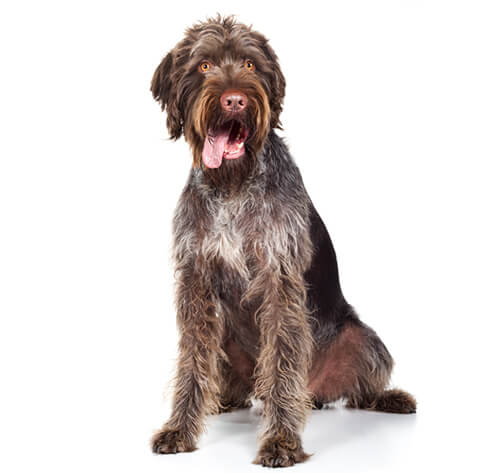
A multipurpose hunting dog, the German Wirehaired Pointer enjoys human companionship and bonds closely with his family. An exceptional pointer and retriever, the breed is eager to please and enthusiastic to learn. Highly energetic, the German Wirehaired Pointer requires vigorous daily exercise. The breed’s coat sheds lightly but is easy to maintain.
DID YOU KNOW? The German Wirehaired Pointer has webbed feet, which help him to excel at swimming.
ALSO KNOWN AS: Deutsch Drahthaar, Deutscher Drahthaariger, Vorstehhund, Drahthaar
The need-to-know
- Dog suitable for owners with some experience
- Some training required
- Enjoys vigorous walks
- Enjoys walking more than two hours a day
- Large dog
- Some drool
- Requires grooming every other day
- Non hypoallergenic breed
- Chatty and vocal dog
- Not a guard dog
- May require training to live with other pets
- Great family dog
Personality

Gentle and even tempered, the German Wire-Haired Pointer is a friendly, hard-working companion, and while they lack a little of the speed of their smooth coated cousins, they are the stronger, more rugged of the German Pointers, and really can go all day. Keen to learn and affectionate to their loved ones, the GWP needs to be well exercised mentally and physically, and to spend quality time with their family to remain happy and well-balanced.
History and Origins

Country of Origin: Germany
Germany has a long history of hunting with dogs and particularly with wire-coated multi-function dogs that are hardy, resilient and can point, flush, and retrieve in all weathers. It is hard to pin-point the GWP’s exact ancestry, as breeders were more interested in function than appearance and so bred from dogs with good working records that suited their needs rather than dogs that looked the same! As the GWP was one of the less speedy gundogs, they nearly died out as a type, until a local breeder who recognised their value set out to save them in 1865. It wasn’t until 1970 however that the breed was officially recognised. It is possible the German Wirehaired Pointer has links to Airedale Terriers, Foxhounds, possibly even French Griffons as well as other German pointing breeds.
Nutrition and Feeding

Large breed dogs, such as the German Wirehaired Pointer, as well as having large appetites, benefit from a different balance of nutrients including minerals and vitamins compared to smaller-breed dogs. Discover more about how to offer your dog a balanced diet with our easy-to-follow guide.
Exercise

This is the ultimate in all-terrain, all-weather outdoor dogs. The German Wirehaired Pointer needs at least two hours of daily dog exercise, ideally involving some scent work, free running and training across a variety of routes. If you enjoy running, gundog sports, working and field trials, agility, even falconry, this may be the ideal breed for you. They will enjoy sharing the sofa with you as well, but only after a full day out and about, working their nose, legs and brain! A bored GWP however will find their own entertainment and can become destructive.
Other Information

Health and Common Issues
The German Wire-Haired Pointer is generally a healthy breed. However, as with many breeds, they can suffer from various hereditary eye disorders, and hip dysplasia (a condition that can lead to mobility problems). Eye testing and hip scoring of dogs prior to breeding is therefore important. Epilepsy is also seen more commonly in this breed. Check with the Kennel Club and breed clubs for the most up to date health information.
Space Requirements
This is a medium to large active dog that wants to be out and about in all weathers. Not ideally suited to small homes or town/city homes, but excellent in the rural or rural-suburban home with a large secure garden and access to a variety of interesting walking routes.
Training German Wire-Haired Pointers
The German Wire-Haired Pointer is easy to train if you understand their motivation (hunting, retrieving, carrying things in the mouth, food) and are willing to work hard to have them believe that working with you will lead to all the good things in life. Dog training for this breed will be an on-going daily thing for life rather than something you do in one-hour sessions at the local village hall. Pay particular attention to recall, and retrieve as GWP’s are independent thinkers and can cover a lot of ground and adore carrying things in their mouths which can lead to conflict if not understood.
Best Family Dog Breeds
A great companion for the active family with older children who enjoy long walks and dog training as a hobby. Not ideal for those with very young families or those who do not have the time to commit to the GWP’s exercise and training needs. While many dogs are traditionally thought of as being good with children, all dogs and children need to be taught to get on with each other and be safe together. Even so, dogs and young children should never be left alone together and adults should supervise all interactions between them.
Did You Know?
In Britain in the 1800’s the trend was to develop specific dogs for each hunting task, hence the wide variety of spaniels, setters and pointers we have today! In mainland Europe however breeders focused on producing all-rounders, the ‘Hunt/Point/Retrieve’ or HPR breeds. These dogs, of which the German Wire-Haired Pointer is one example, were excellent at hunting, pointing, flushing, springing and retrieving, meaning all those jobs could be done by one dog. European efficiency at its best!